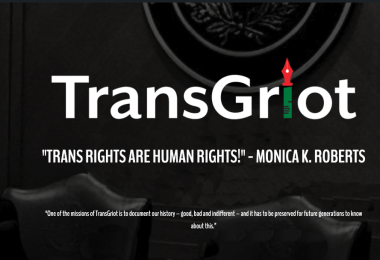Black Twitter be wildin’
In late July, “comedian” Jess Hilarious responded to TikToker @itsblessingrose, who explained that cis women are not the only people who have periods. Blessing Rose, a Black trans woman, used her platform to include the various people who might menstruate but are not cisgender women. The Shade Room, a Black-owned tabloid site—notorious for its queerphobic content—picked up Blessing Rose’s video. It went viral across several social media platforms, specifically in Black spaces like Black Twitter and Black TikTok.
In her response, Jess Hilarious asked the internet, “Who’s going to stand up for us?” She explains that by “us” she means “real women.” “Real women” is a classic rhetorical move that dehumanizes trans women and robs many of us of our womanhood. Jess Hilarious’ video sparked a larger conversation in Black digital spaces about the alleged “attack on Black cis women.”
In a tweet, trans activist Ts Madison stated:
There are sooooo many “Real” women that get mistaken for being “transgender” Women and that’s where a lot of the anger comes from…. I do hope they take a Good look at how Transphobia affects ALL women……
https://twitter.com/TsMadisonatl1/status/1682813751014064129
Ts Madison describes the frequency with which Black cis women are mistaken as transgender—a common form of misogynoir that strips Black women of their femininity. People accuse cis women, just like they do trans women, of being “men in dresses” because they might be tall, have a deeper voice, are athletic, have a specific jawline, or dress a certain way. In fact, this form of anti-Black misogyny is directly linked to chattel slavery where enslaved Black women’s femininity was forcibly repressed to further distinguish them as sub-human and inferior to the white women on slave plantations.
Black cis women who have been targeted by such misogynoir include Serena Williams, Megan Thee Stallion, Wendy Williams, Michelle Obama, and even Jess Hilarious herself. Ts Madison additionally, and importantly, notes that transphobia does not just affect trans women, but all women. In fact, cis women have been violently attacked for presumed transgender identity, and many anti-trans healthcare laws are impacting cis people as well.
Defining “Transmisia”
Planned Parenthood distinguishes between Transphobia and Transmisia: “Transphobia and transmisia are basically the same. However, transphobia means ‘to be fearful of transgender people,’ which isn’t an accurate way to talk about oppression.” They give 3 reasons as to why:
- In medical language, phobias are anxiety disorders. So, saying “transphobia” is unfair to people who have actual phobias.
- Even if someone has fear about trans and nonbinary people — like fear of the unknown or a changing world — it isn’t a phobia.
- Because “transphobia” sounds like an individual condition, the word downplays systems and institutions that harm trans and nonbinary people.
Furthermore, they state that “The “misia” in transmisia means “hatred.” This is a helpful word because it highlights the prejudice at the root of beliefs, attitudes, behaviors, and systems that hurt or deny the existence of trans and nonbinary people.”
I was first introduced to transmisia by Black trans activist Hope Giselle when she joined Ts Madison for her YouTube series, “The Maddie in the Morning Show” to discuss transphobia and transmisia in the Black community. Like Planned Parenthood and Hope Giselle, I find using transmisia to be particularly helpful because it centers the behavior and actions as something systemic and ingrained in our institutions. Giselle’s articulation of this specific kind of prejudice (anti-Black transmisogyny happening in digital spaces) came only days after her efforts to help mobilize people in Baltimore after a Black trans woman was violently harassed and attacked. After this attack, many comments on social media were fueled by digital transmisia, essentially blaming the victim.
Social media spaces like Twitter, Instagram, and TikTok can, and do, exist as systems of anti-trans rhetoric. These platforms can perpetuate mis and disinformation, stereotypes, and harmful narratives, which then fuel anti-trans policies. Transmisia then provides a valuable term for discussing how digital spaces can operate systematically to oppress trans people.
But these same spaces also offer opportunities for resistance.
Black Trans Digital Activism
After a group of men in Baltimore attacked a Black trans woman, Hope Giselle took to Instagram as a way to organize. On Instagram, she shows the video of the attack and provides her analysis:
Being a trans person. I know how these niggas work. I know how these nigga operate. And I understand how these situations play out and I understand how they tend to play out on social media. So what I’m going to give you all is the nuance as per my own lived experiences and how I know that these niggas like to play and then use social media to amp up their bad behavior.
https://www.instagram.com/reel/CxwJpySrYcL/
Hope Giselle recognizes the power of storytelling and personal narratives. She and many other trans women have utilized social media to explain their own experiences and to dispel dominant—and usually false—narratives about trans women. TikTok has become a prominent place for trans people to tell their own stories and to intervene in inaccurate and harmful information on social media.
Zaya Perysian posted a TikTok explaining how trans-affirming healthcare is life-saving. Her TikTok was a direct response to the numerous efforts to prevent trans youth from having access to hormones.
Kat Blaque is a Black trans YouTuber. Her vlog series, True Tea, uses her lived experience to tackle issues of race, gender, sexuality, and class.
Ts Madison’s YouTube video called “B**ch Im BLACK” uses spoken word as a storytelling method for describing her experience as a Black trans woman, noting the intersectional issues that Black trans women have to navigate. Ts Madison focuses on transmisia within the Black community. Her video comes months after George Floyd’s murder and she contextualizes her experience within Black liberation movements to argue for the liberation of all Black lives, not just cisgender Black lives.
Beyoncé sampled audio from Ts Madison’s video and included it in her Renaissance album (i.e., “Cozy.”) She samples Ts Madison’s declaration “I’m dark brown, dark skin, light skin, beige, fluorescent beige, bitch, I’m black.” Fittingly, Renaissance is an album that incorporates ballroom—a culture pioneered by queer and trans people of color. Beyoncé’s amplification is significant not only because she highlights trans of color culture and showcases an example of Black trans digital activism, but also because her amplification occurs during a moment of heightened anti-trans rhetoric and legislation.
While digital anti-Black transmisia continues to power anti-trans politics, Black trans activists also use these platforms to combat anti-Black transmisia. Additionally, storytelling is a common and effective rhetorical strategy for dispelling misinformation/disinformation and harmful narratives about trans people. Liberation movements have long used storytelling in their activist and organizing efforts even before social media. Spaces like Twitter, TikTok, and YouTube provide platforms for trans people of color to tell our own stories, explain our own lived experiences, and organize our own communities.







